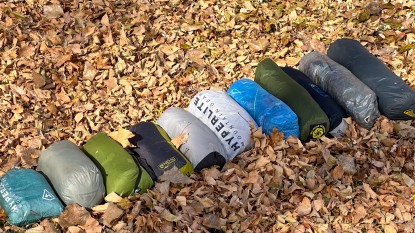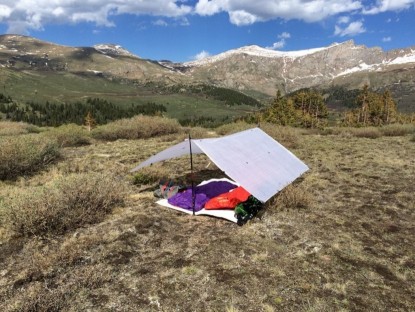Some people love the Trailstar, but over the years our testers have developed a strong preference for flat tarps or pyramids. If you want a spacious tarp that can handle epic weather, we suggest getting a pyramid tarp, specifically the Mountain Laurel Designs SuperMid.
Like many of the ultralight shelters we tested, the TrailStar is not widely available on at major online retailers. The Black Diamond Beta Light however, is available at many online retailers, often on sale.Mountain Laurel Designs TrailStar Review
Our Verdict
Our Analysis and Test Results
Performance Comparison
Livability
The Trailstar can pitch in many different configurations that offer varying degrees of comfort. The most common configuration (both for our testers and, an image search reveals, by the masses) is pitching it with a taller trekking pole in the middle and a medium length pole at the entrance. As long as you keep the angles right, the Trailstar is highly customizable. With long lines, it can be pitched several feet off the ground or buttoned down tight against the ground. When pitched with 6-8" between the bottom wall and the ground, the shelter provides two people with lots of space to lay down and to store gear. Headroom is less plentiful in another configuration. With the Trailstar locked to the ground, it's admittedly difficult to enter and exit.
Weather Resistance
Wind glides over the Trailstar as fast and as fluidly as an Olympic speed skater. It's difficult to estimate just how sturdy the shelter is in very high winds — it depends largely on stake and soil type and other campsite characteristics — but we believe that it's capable of protecting you in every condition found by backpackers. Pitching it around 120cm height works well for most conditions and dropping the center pole to around 100cm allows you to lock the edges close to the ground. The Trailstar's longer walls, when compared to most A-frame and flat tarps, reduce the amount of force applied to each tie-out, which is critical because it can be difficult to truly lock the edges of many tarps to the ground. The Trailstar feels very safe and secure in high winds.
The low flat design is much less capable of handling snow loading, however, when compared to mids. A few inches of snow in the shoulder season is no problem, but we don't believe the Trailstar is suitable for winter nights that bring 6+ inches of snow. Mids with four steep walls do much better with snow loading.
The Trailstar is cut from high quality 30 denier silnylon and constructed with an attention to detail that few other silnylon shelters can match. Unlike most self-supporting double wall tents found in our backpacking tent review this is a shelter that's competent on extended trips to the planet's most remote areas. When sleeping in the Trailstar during a severe storm far from the nearest trailhead one feels comfortable and secure and confident that the shelter will not break.
Weight and Packed Size
Our silnylon Trailstar weighed 18 oz. before we seam-sealed it and attached a generous amount of guyline. Afterward, it weighed 22.1 oz. You can save some additional weight by purchasing lighter guyline that doesn't absorb as much water.
Adaptability
The Trailstar is adaptable in that it can pitch in a variety of ways. Unfortunately, each configuration is relatively similar and takes up a large area. In our rating, we score the Trailstar higher than pyramid tarps and considerably lower than A-frame and flat tarps. The Trailstar is rather poor at adapting to sites that require a suboptimal pitch.
Limitations
The Trailstar is limited by its large footprint. While testing the shelter in the High Sierra, we were unable to camp in sites that accommodate pyramid tarps and many self-supporting tents. When walking through rocky terrain, it can often take much longer to find a suitable campsite; if pitched close to the ground the long, low walls may touch rocks close to the perimeter, which, when combined with wind, may abrade the silnylon. Pitching requires a relatively large flat area free of obstacles, perhaps 12 ft. by 12 ft. in area. Therefore, it's important to consider if the terrain will accommodate the Trailstar. In most places, and certainly in many established campsites in forested areas, the shelter goes up without a problem. Some long-distance hikers and those that travel off trail in may find a shelter with a smaller footprint to be better for their needs. The magnitude of this drawback will largely depend on the terrain that you plan to travel through and if venturing through rocky or densely forested areas, your ability to identify potential campsites in advance.
When the wind changed direction at night, we had to get out and reposition the door so that it didn't catch as much wind. This issue can be annoying, as it requires repositioning multiple tieouts, but choosing good campsites can largely mitigate the problem.
Both for first-time users and experienced users, the Trailstar is more challenging to pitch than many other shelters tested here. It's not terribly difficult, but it does take longer and requires more finagling than pyramids and the A-frame tarps we've tested.
The Trailstar walks the line between being a tarp and a mid, but we don't believe that it matches the performance of mids in winter weather. This model is a do-it-all 3three-season shelter, not a four-season shelter capable of significant snow loading.
Best Application
We believe the Trailstar is best suited to camping in exposed areas with high winds that have large campsites.
Value
$230 for a top-of-the-line bombproof shelter! This is an excellent value.
How to Get It
The Trailstar is not sold by major commercial or online retailers. Get it online at
It's important to note that Mountain Laurel Designs has a heinously long wait time and that their website is difficult to use and is rarely updated. Through purchasing at least five products, we've found that it usually takes 4 to 10 weeks to get something from their online checkout to our doorstep. Mountain Laurel Designs builds excellent products and offers custom options on everything they make, but you must plan ahead.
Check out this fun setup video.





